|
Planetarium
The Planetarium in Toronto, originally part of
the Royal Ontario Museum, was built in 1968. It was a gift from
industrialist and philanthropist Col. Sam Mclaughlin
A huge unadorned concrete dome that offered daily
excursions to intergalactic space. The projector was taken out
a few years ago. The building was sold to University of Toronto,
and now a small group of people called PLANETARIUM TORONTO are
trying to restore it to its natural place in the Universe. let's
hope they are successful.
|

Planetarium Toronto
|
|
Colonnade
Bloor Street Toronto
Concrete is also used to create one of the first
really classy shopping area of the Modernist age, The Colonnade
in Toronto. Surrounded by exclusive shops and boutiques, this
area still attracts the discerning (read wealthy) shopper. Concrete
was the favorite material of Le Corbusier, the French philosopher
and architect who was responsible for so much Modernist material
through the International movement.
|
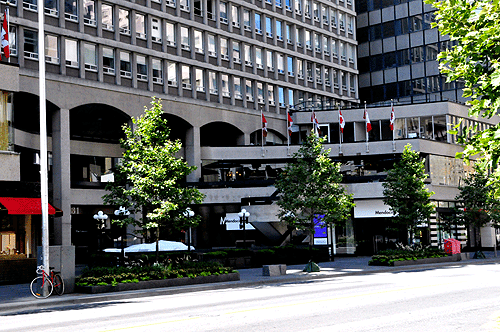
Colonnade Bloor Street Toronto
|
|
Eatons
Marquee
Downtown Toronto still has a few other Modernist
gems like the Vitrolite and chrome marquee on Yonge Street.
|

Colonnade Bloor Street Toronto
|
|
Thunder Bay
This classic 'machine age' or mid-century modern
building in Thunder bay has had a wide variety of owners. The
corner cabinet with the curved glass seems to float within the
wall. The chrome outline makes the inside just glitter. The
walls are vitrolite and the floor is original terrazzo in a
starburst pattern. This flooring has been used in commercial
and civic buildings for years. It looks as good in 2012 as it
did in 1950 and it should last another 200 years or more. No
one knows why the idiots in renovation keep either tearing it
out or covering it with last-weeks-cutting-edge slate or tile.
|
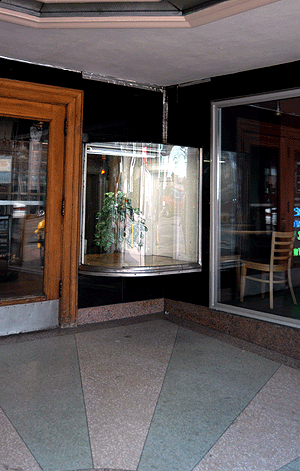
Colonnade Bloor Street Toronto
|
|
Daily
News Building London England
Vitrolite is a material that was used sparingly
during the Art Deco period between the wars, but then took off
during the age of diners and pharmacies with ice cream counters
in the 1950s. Vitrolite can also be found in many wall decorations
and in cafés and bars in Europe. It leant itself well
to the flighty, extravagant designs of the ‘Roaring Twenties'.
One well known major icon is the Daily News building in London
England. This four storey beacon to the cool is meticulously
maintained and contains most of the original interior lighting
and fixtures as well as the flawless Vitrolite on the outside.
Found near the financial district of London, it gets a load
of foot traffic and is a fixture on an otherwise eclectic street.
Next door is a building dating from the 17th century. The British,
indeed most Europeans, can identify a good building when they
see it and they make few mistakes when it comes to preserving
their heritage. The interior of this building is only available
for viewing by appointment.
|
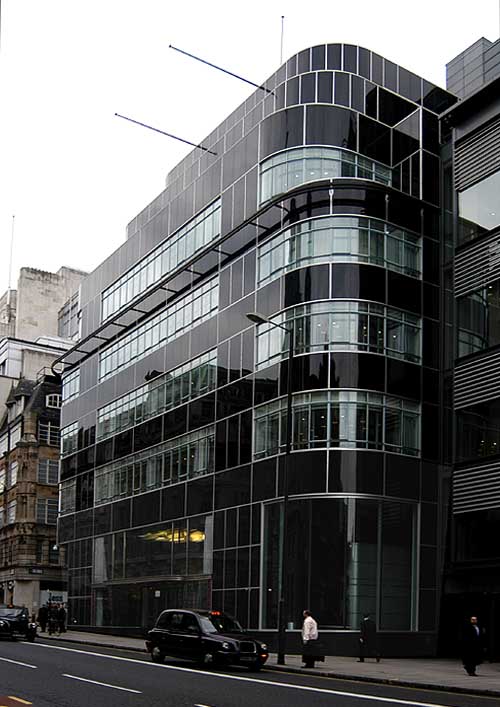
Daily News Building London England
|
|
Stratford
festival Theatre
The tent-like roof and design can also be found
in the Stratford Festival Theatre and the park in Toronto Island.
The design was inspired by the Festival of Britain, 1951.
|
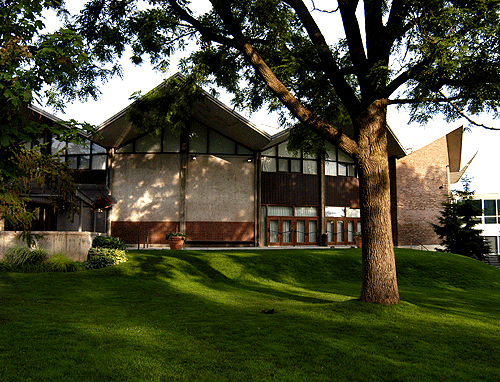
Stratford Festival Theatre - Stratford Ontario
|
|
Lord
Landsdown School
Lord Lansdowne Public School in Toronto makes
another interesting use of concrete, steel and brick with its
extravagant flying buttresses.
|
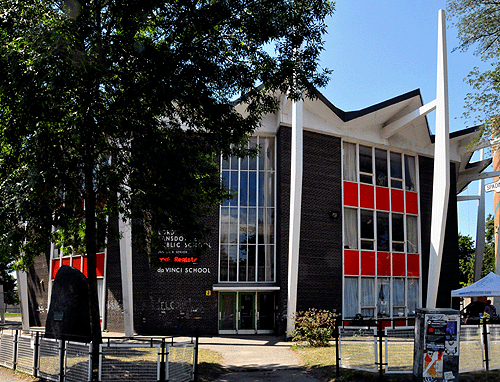
Lord Lansdowne Public School in Toronto
|
|
Highland
Secondary School
Lloyd Kyles
|
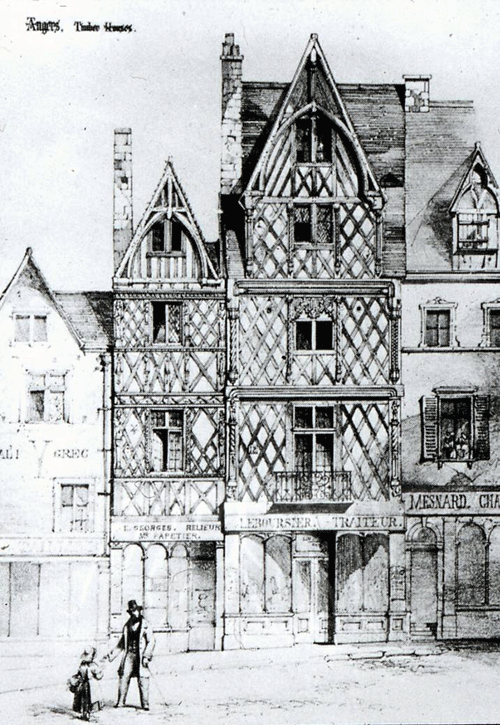
One of Shaw's 'Sketches from the Continent' - Anger France
|
|
Parkside
High School Dundas
Lloyd Kyles who won an award for the most innovative
structural design in Canada in 1959 for his work on Parkside
High School. The outside walls and spandrels were precast reinforced
concrete sections with marble chips inserted in the precasting,
Kyles' original idea. The reversed arch concrete roof was poured
in place - in situ. The building is a small gem mixing mosaics
by Ross Robinson, floor lighting, a sweeping opening terrace
and windows overlooking Dundas driving park.
|

Parkside High School Dundas
|
|
Parkside
High School Dundas
Lloyd Kyles who won an award for the most innovative
structural design in Canada in 1959 for his work on Parkside
High School. The outside walls and spandrels were precast reinforced
concrete sections with marble chips inserted in the precasting,
Kyles' original idea. The reversed arch concrete roof was poured
in place - in situ. The building is a small gem mixing mosaics
by Ross Robinson, floor lighting, a sweeping opening terrace
and windows overlooking Dundas driving park.
|

Parkside High School Dundas
|
|
Parkside
High School Dundas
Lloyd Kyles who won an award for the most innovative
structural design in Canada in 1959 for his work on Parkside
High School. The outside walls and spandrels were precast reinforced
concrete sections with marble chips inserted in the precasting,
Kyles' original idea. The reversed arch concrete roof was poured
in place - in situ. The building is a small gem mixing mosaics
by Ross Robinson, floor lighting, a sweeping opening terrace
and windows overlooking Dundas driving park.
|

Parkside High School Dundas
|
|
Wentworth
House
Also by Kyles, Kyles and Garrett, Wentworth House
at McMaster University
|

Wentworth House McMaster University Hamilton
|
|
Parkside
High School Dundas
Lloyd Kyles who won an award for the most innovative
structural design in Canada in 1959 for his work on Parkside
High School. The outside walls and spandrels were precast reinforced
concrete sections with marble chips inserted in the precasting,
Kyles' original idea. The reversed arch concrete roof was poured
in place - in situ. The building is a small gem mixing mosaics
by Ross Robinson, floor lighting, a sweeping opening terrace
and windows overlooking Dundas driving park.
|

Parkside High School Dundas
|
|
Hendrys
Shoes Hamilton
Vitrolite is a material that was used sparingly
during the Art Deco period between the wars, but then took off
during the age of diners and pharmacies with ice cream counters
in the 1950s. Upscale shoe stores like Hendrys were also perfect
for the new sleek shoes and accessories that were worn by the
Modern person.
|
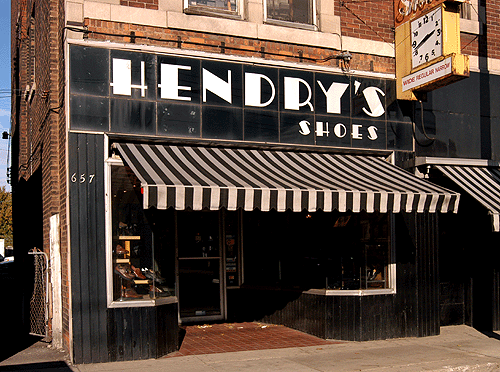
Heendries Shoes Barton Street Hamilton
|
|
Nipigon
Cafe
The wonderful glass brick foyer and original sign
make this the eating place of choice in Nipigon. A lot of the
interior is original too.
|
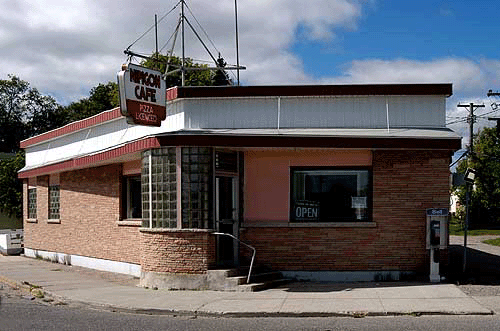
Nipigon Cafe
|
|
Sadly
Remembered The DeLuxe
Another icon of the Dundas building scape was
The DeLuxe, a diner kept intact by its owner for over 50 years.
It had the original chrome stools, the original counters, the
original booths and flawless Vitrolite on the front.
In 2008 it was bought by a chain and destroyed.
The restaurant is now successful, but it will be successful
without my patronage.
|

Parkside High School Dundas
|
|
Mid-century
Modern in Eastern Ontario
|
Most towns in Ontario have at least one Mid-Century
Modern suburb. For those who are looking to purchase a 'first
home', these are very good value for the money. They are
already wired and plumbed. You don't need to figure out
where you are going to 'cheat in' a bathroom because they
all had them already. In addition, under the modern carpet
or linoleum you can usually find a beautiful hardwood floor.
|
|
The Queen Anne style always has a verandah,
sometimes wrapping all the way around a house. There are
many small rooms where each member of the household could
find some peace and quite. The style is opulent without
the ornament found in Italianate or Italian villa. The house
often has a tower, but the styling of the tower has no balconettes
or eyebrow window treatments.
An offset of the style found in Canada is the
Stick style of the eastern US.
Queen Anne houses are sometimes referred to
as 'painted ladies' because they are so colourful and full
of lacy details, as can be seen in the examples from Hastings
and Durham.
|
|
|
Belleville
The gazebo in the park
in Belleville
|
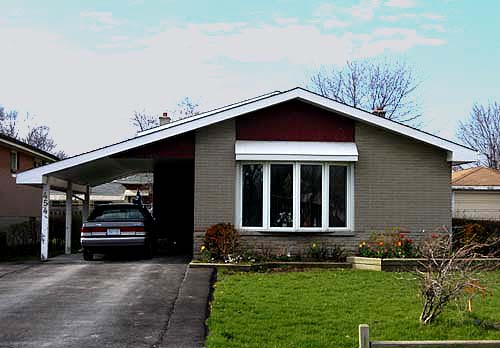
Brockville Ontario
|
|
Belleville
With the postwar economic
boom people were buying cars and thus had easy access to rapidly
growing suburbs. The small windows
and clean surfaces of the International
style were replaced by façades
with a variety of surface finishes and large picture windows.
The roof generally sloped further on
one side than another to incorporate a carport or roofed terrace.
This house has an angel stone base, brick and cedar paneling
all on the same facade.
|

Belleville Ontario
|
|
Mid-century
Modern in Central Ontario
|
Larger cities in Ontario seem to be loosing
their Mi-Century Modern very quickly. Despite the fact that
Madmen has inspired interior design changes, clothing lines,
light fixtures, and restoration projects across the continent,
some neighbourhoods are being bought up by speculators who
have no taste
|
|
and no intention of actually living in the
areas that they are buldozing. Classy little buildings are
being replaced by supersized Garagemahals at an alarming
rate. Wake up people. These are your neighbourhoods that
are being ruined. Is this really what you want?
|
|
|
Ancaster
The slightly sloping, off- center roof
and alternating vertical bands of brick and windows mark this
as a Mid-century Modern home. The placement of the garage also
makes it a Side Split. Unlike some
of the others, the windows in this
are all rectangular, rather than following the slope of the
roof. The doorway is simple, as are
the windows. The roof cornice or,
in this case, fascia, is large but not molded.
|

Ancaster Ontario
|
|
Vaughan
This Mid-century Modern house
is nicely nestled in the countryside. The front façade
is a long bank of windows that are custom fit to match the undulations
of the roof. The windows are framed with plain, clean, white
boards that create a "moderne" pattern. The exterior
walls are made of orange brick, and the other trim and finish
is yellow, creating a bright, cheery look.
|

Vaughan Ontario
|
|
Kitchener
This Mid-century
Modern house is in a more upscale neighborhood and has a much
more dynamic façade. The roof
slope is still very low, and there are many different materials
in the same façade. Vertical wood paneling is found with
large plates of unadorned window glass and stone. No window
surrounds are present.
|

Kitchener Ontario
|
|
Hamilton
On large apartment buildings,
the fenestration is understated,
and balconies are generally large,
blocky and colourful. The ornate porticos
of earlier styles are replaced by a "butterfly" or
inverted wing portico that encompasses space for a car.
Mid-century Modern styles are self-consciously
free of any historical detail. Window
surrounds are nonexistent. Doors are single pane and often
sliding. Doors and windows are placed according to interior
functional requirements and the comfort of the inhabitants as
opposed to exterior design.
|
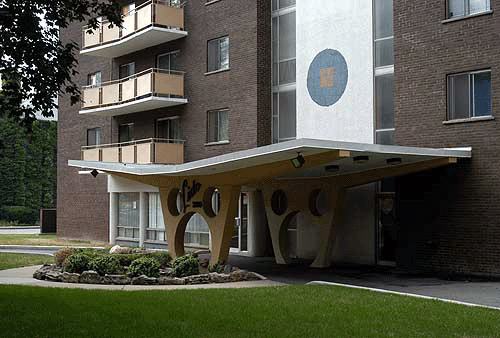
Hamilton Ontario
|
|
Toronto
The beauty
of many Modernist buildings is that they purely and simply elegant.
This long low house designed by architect George Boake of Crang
& Boake for his family, 1956, is a brilliant example of
that kind of thinking. It is a lovely little house with an inviting
doorway.
|

Toronto Ontario
|
|
Toronto
Glass
brick has been used by architects for many years to produce
translucence without transparency. Mid-century modern buildings
do this better than any others.
Note as well the texturing in
the warm orange brick. The horizontal bands emphasise the length
of the building. It is casual but refined. The thick wood door
with a natural finish is also a popular mid century design element.
|
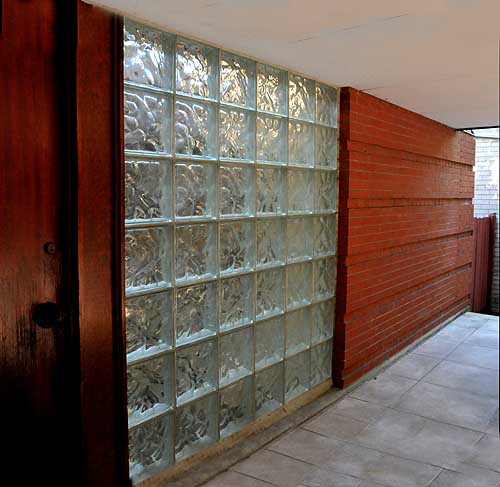
Toronto Ontario
|
|
Toronto
Just around
the corner is another Mid -century building that leans more
to Art Deco than to Frank Lloyd Wright. The front door is recessed.
The jambs are extremely large and curved in the Art Deco style.
Interesting that window companies don't seem to be able to make
windows like this any more. The muntins in the sidelights are
chrome. A sleek enameled black door with sidelights invites
you in.
|
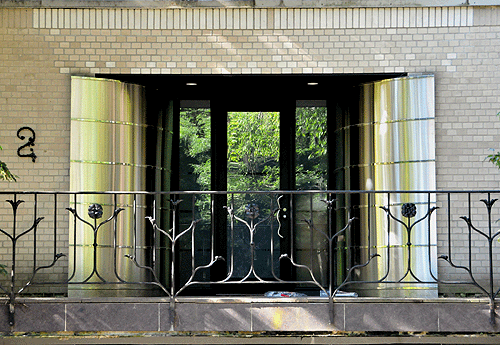
Toronto Ontario
|
|
Toronto
This beautiful gem of a house was designed by
Peter Dickinson. Like Frank Lloyd Wright Houses, the emphasis
is not on the doorway. It is almost like approaching a cave
or a Greek dell with a home inside.
Field stone walls, clerestory lights and loads
of cedar are the design elements.
|
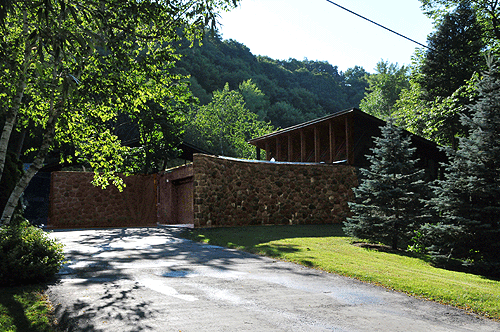
Toronto Ontario
|
|
Hamilton
Leaning a bit towards the Art Deco again, this
charming little suburban building is crisp and compact.
|
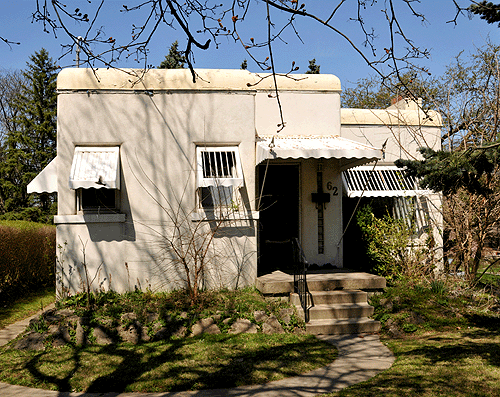
Hamilton Ontario
|
|
Hamilton
The awnings have metal blinds that can be adjusted
from inside thw building. The sills are simple. The window surround
is curved in towards the window itself.
|

Hamilton Ontario
|
|
Dundas
Thisfireplace has most of the design elements
found in Mid-century design.
The background is plywood, stained and urethaned.
The finish has been fine for 50 years, no painting required.
The brick in the chimney is stack bond - obviously not structural,
it is a finish. The mantel is a simple curve that extends to
the floor on one side past the elevated hearth. The hearth is
cantilevered out from the fireplace.
Exposed ceiling beams and a tongue and groove
wood ceiling complete the mid-century look.
|

Dundas Ontario
|
|
Dundas
Another classic Mid-century look is the half-round
chimney in stucco. Small ceramic tiles are used above the fireplace
opening while brick is used to create the hearth, a spot for
firewood - a modern firebox, and a small nook for sitting.
Linoleum is used on the floor.
|

Hamilton Ontario
|
|
Hamilton
Plywood was another mid-century material that
took off like a shot. This material was new, strong, and capable
of providing flat surfaces for roofing, flooring and wall preparation.
The concept of laminated wood had been around since the Egyptian
times, and was used sparingly in the 19th century for industrial
uses. It was only in the 1930s when waterproof adhesives were
invented that it began to take on its rightful place in the
Modernist movement. Builders were quick to see the value of
four foot by eight foot sheets that retained their structural
integrity. Mass production was well in place by the 1950s and
has not stopped since.
|
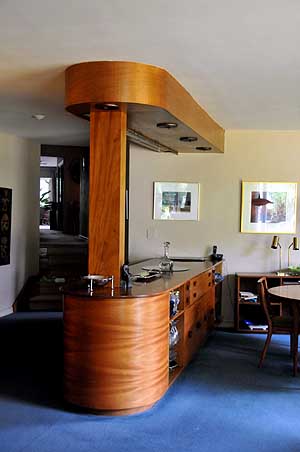
Hamilton Ontario
|
|
Hamilton
In Plywood production, the sheets can be made
either with a rough surface or with a thin veneer of precious
wood. This finished surface could then be stained and varnished,
and the resulting finish is both beautiful and durable. Sadly
the 1970s came up with a ‘fake' wood surface that became
the cheaper version of wall paneling, very popular with Wayne's
World, and the Plywood surface was discredited. Still, it is
an amazing material. Notice how it can bend around a radiused
surface to create a lovely built-in buffet. Cutting edge 21st
century architects are rediscovering Plywood as the wall finish
of choice.
|
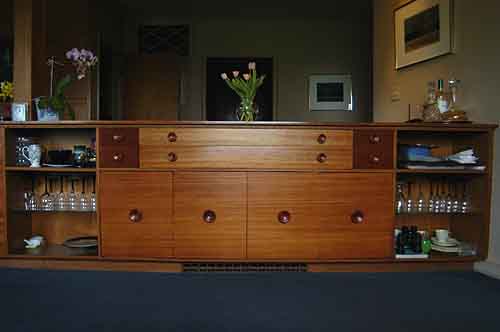
Hamilton Ontario
|
|
Hamilton
Mid-century Modern is all about the built-in.
Most Modernist houses have a bench or chair in a ‘cubby
hole' that was intended for the telephone. A small shelf was
usually provided to fit the Bell Telephone book.
Other ‘built-ins' included the chair beside
the front door. This chair was used to remove boots and shoes
as well as to don the plastic covers for high heeled shoes.
|
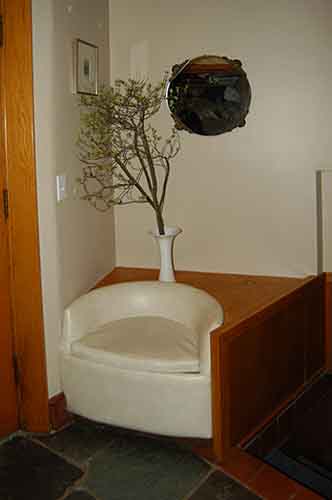
Dundas Ontario
|
|
Mid-century
Modern in Western Ontario
|
Suburban houses sprouted up all over the province.
Often vernacular materials were used, but the basic design
was the same. The roof slope was not symmetrical. The roof
was intended to extend over the car port.
|
|
Large picture windows were part of the design.
Many older houses were 'upgraded' to include a picture window
in the front.
|
|
|
Sault
Ste. Marie
Like the other Mid-century Modern
examples, this façade is compiled from a variety of textures
and finish materials. There are no sidelights or transom
on the door. The large picture window in the front is equipped
with a sliding component for air flow.
Like the Prairie
school designs, the fireplace in this house is in the center
of the building. While the Prairie style was the innovative
style for the wealthy at the turn of the century, the Mid-century
Modern was the style for individuals and families in the postwar
era.
|

Sault St Marie Ontario
|
|
Thunder
Bay
The dynamics of the family home had changed drastically.
In 1900, the large home had servants to stoke the fire for coal
or wood burning furnaces. By 1950, architects were looking into
solar heating and power- saving alternatives. As a result, many
Mid-century Modern style homes have floor to ceiling windows
on the south side of the house. The large overhang was calculated
to produce shade in the summer and a maximum of sunlight in
the winter. Window designs were built on rectangular patterns
as opposed to the floral or circular
patterns of earlier styles.
|

Thunder Bay Ontario
|
|
Thunder
Bay
Most homes were long and low with a lot of windows.
The windows could be cut on angles or clustered as in this example
from Thunder Bay.
|
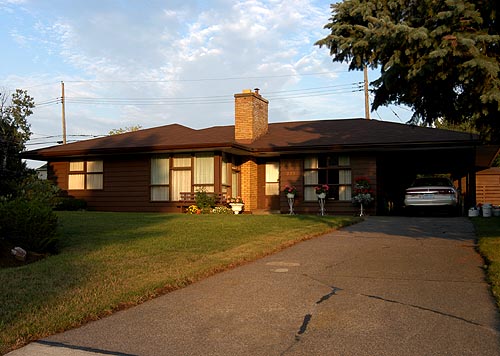
Thunder Bay Ontario
|
|
Thunder
Bay
A more dynamic façade
allows for many different light sources. For privacy, the windows
admitting light facing the driveway are clerestory;
light enters the building but no one can see in. The
central fireplace cuts the design in two. The entrance or public
area would have a fireplace opening and the private area would
have an opening on the other side. Like the original Prairie
designs, this is all on one level, a long rambling floor plan
that opens out onto an interlocking hallways. The exterior materials
are all natural: cedar rather than painted wood and natural
coloured brick.
|

Thunder Bay Ontario
|
|
Fort
Erie
It is sometimes difficult
to say where International or Art Deco stop and Mid-Century
Modern begins. This is a good example of that. This building
could be International, but the lovely curve and glass brick
make it Mid-Century.
|

Fort Erie Ontario
|
|
Design
Features of Mid-century Modern
|
Part of the appeal of Mid-century Modern is
all the cool stuff that was invented and designed during
the age. A great many light fixtures and kitchen aids now
available in box stores such as Ikea are cheap knock offs
of 1950s designs.
|
|
Colour choices in the 21st century also seem
to be very close to those of Mid-century.
|
|
|
Lotte Lamp
For residential projects, a new line of lighting
and lamps used new materials such as plastic, fibreglass and
even Styrofoam. Cheeky designs with fibreglass shades came in
all the ‘cool' colours. Distinguishable among these are
the Lotte lamps which, like most other mid century furniture
and decoration, was a design inspired by Danish modern.
The Broslund family moved to Canada from Denmark
just after the Second World War and opened their factory in
Oak Ridges Ontario. The fibreglass lamp shades developed by
Morten, the son in the family, are so strong you can literally
stand on them.
|

Annapolis Royal Nova Scotia
|
|
Fibreglass
Fibreglass was used for
a great many things in Mid-century design. Corrugated fibreglass
was used as siding and roofing for summer houses and sheds.
Most often, however, fibreglass was used for lighting
because of the beautiful luminescence of the material. Cheeky
designs were easily made. These lamps can now be found on ebay
and kijiji as well as fabulous shops dedicated to midcentury
design such as
ethel20thcenturyliving on Queen Street in Toronto
|

Annapolis Royal Nova Scotia
|
|
Stoves
Modern Conveniences were being produced in grwat
profusion. Here is an example of a stove. Four cooking elements
fold back up into the wall to allow greater space for counter
work.
|

Hamilton
|
|
Dundas
Architects and designers
were re-thinking everything. Here the railing on the stairs
has not handrail. The spindles extend right up to the ceiling.
Each spindle acts as a grip. I wonder if this would still pass
the Building Code Requirements?
|
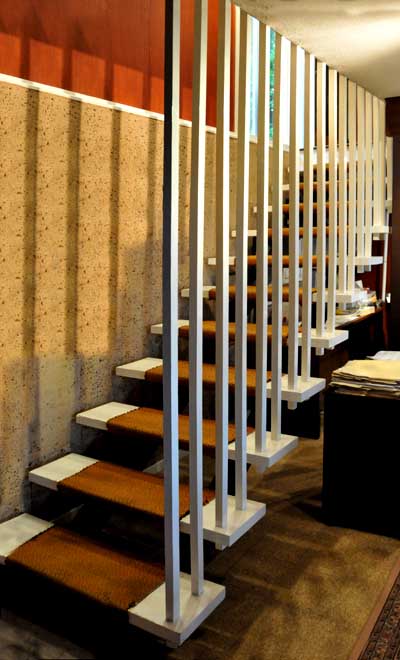
Dundas
|
|
Queen Anne Extra
Reading and Films
|
Books
MacRae, Marion, and
Anthony Adamson. The
Ancestral Roof: Domestic Architecture of Upper Canada.
Toronto: Clarke, Irwin, 1963.
|
|
Films, TV and Websites
http://robertmoffatt115.wordpress.com/
http://historicalhamilton.com/history-and-heritage/sleek/the-roscoe-house/
Mad Men - TV series
North by Northwest - Alfred Hitchcock
|
|







































